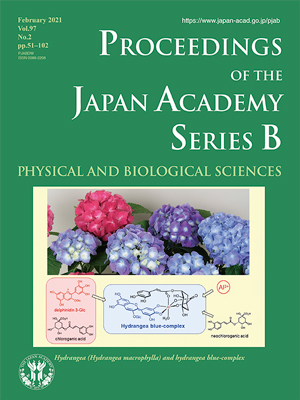About the Cover
Vol. 97 No. 2 (2021)
Hydrangea (Hydrangea macrophylla) is a unique flower because it is composed of sepals rather than true petals that have the ability to change their color. This plant originated in Japan and East Asia, and its original color is blue. It is portrayed in Flora Japonica by Siebold as Hydrangea “Otaksa” Sieb. Et Zucc. and has been loved in Japan as a rainy season’s flower. During the Edo period, hydrangea was brought to Europe and its red variant was bred, endowing us with varied colored flowers today.
The sepal color can change depending on the cultivation conditions and/or transplantation; this phenomenon has attracted the attention of researchers. Chemical studies on sepal color development in hydrangea started in the 19th century. In the early 20th century, the involvement of acidic soils and aluminum ion in blue coloration was predicted. At the same time, sepal components for color development were revealed as 3-O-glucosyldelphinidin and three copigments, 5-O-caffeoylquinic, 5-O-p-coumaroylquinic, and 3-O-caffeoylquinic acids. Furthermore, the same anthocyanin and copigments were detected in both blue and red sepals. Subsequently, the mechanisms of different color development by the same components and the structure of the blue and red pigments have been vigorously studied. However, the secret was not revealed until the 21st century.
Yoshida’s research group has challenged chemically to reveal the color development of hydrangea for nearly 30 years (this issue, pp. 51-68). They clarified the structure of the blue pigment in hydrangea and named it “hydrangea blue-complex,” which is an aluminum complex comprising 3-O-glucosyldelphinin and 5-O-acylquinic acids shown in the blue box at the center. The ratio of anthocyanin:Al3+:5-O-acylquinic acid is 1:1:1, which was confirmed via mass spectral analysis. The complex is stabilized by a weak hydrophobic interaction between anthocyanidin chromophore and aromatic acyl moiety of the copigment. Then, upon lowering the vacuolar pH and/or changing the composition of the copigments, the equilibrium moves to the decomposition of the complex to yield the red pigment found in the red sepals, which is shown in the red box at the left-side. The complex was directly detected via cryo-TOF-SIMS analysis in the second layer of the blue sepals, where the blue cells are located.
Takeshi Yasumoto
Member of the Japan Academy




